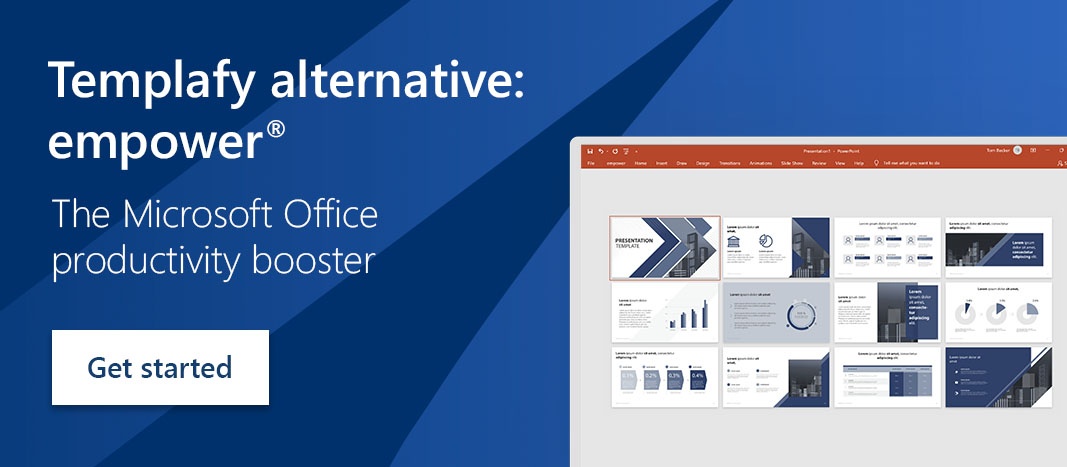Template management systems: brand consistency made easy
In a world where trustworthy and professional brands are critical, companies need to maintain consistent communications and branding. All internal and external documents, from emails to presentations to marketing materials, must be consistent and adhere to corporate guidelines.
But how to do this effectively with a myriad of different and outdated templates circulating throughout the organization?
What is a template management system?
A template management system (TMS) serves as an organization’s secret weapon for streamlining the creation, management, and use of templates. A TMS provides a centralized platform where companies can store, organize, and manage their templates in one place. However, a TMS goes far beyond simply storing templates.
A TMS allows organizations to easily customize, share, and update their templates. It facilitates cross-departmental collaboration and ensures that everyone has access to the latest versions of templates. In addition, a TMS enables compliance with corporate design guidelines by ensuring that all documents are consistent and reflect the company’s brand identity.
Why are template management systems important?
- Error reduction: Templates reduce the risk of errors and inconsistencies in documents. Templates contain content that has already been reviewed and approved, reducing the likelihood of misspellings, incorrect formatting, or missing information. This improves the quality of the documents produced and minimizes potential risks.
- Compliance and branding: A TMS enables an organization to meet compliance requirements and implement consistent branding guidelines. Predefined templates ensure that legal and regulatory requirements are met. In addition, branding guidelines can be implemented for the company’s visual identity to ensure a consistent and professional brand presence.
- Efficient collaboration: TMSes facilitate team collaboration. All team members enjoy central access to the same templates, which makes it easier to collaborate, share information, and edit documents. Everyone is on the same page, and there’s no need to spend time searching for the latest templates.
- Consistency: With a TMS, organizations make sure that their documents, presentations, emails, and other corporate materials have a consistent look and feel. By using pre-designed templates, employees know that the visual appearance and style of their documents conform to corporate guidelines. This promotes a professional and consistent look and feel.

Advantages of a template management system
A TMS offers many benefits to businesses. Some of the most important are:
- Time savings: By using a TMS, employees can save time because they don’t need to create content from scratch each time. Templates can be easily found, selected, and customized, speeding up the content creation process and increasing productivity.
- Brand consistency and professionalism: A TMS ensures that all content aligns with brand identity, including the correct logo, color palette, fonts, and other visual elements. This brand consistency presents the company in a coherent and professional manner. Templates allow less design-savvy users to create visually appealing slides.
- Updateability: With a TMS, all templates can be easily updated to reflect changes or updates to brand identity or company policies. All content is always up to date and meets requirements.
- Increased efficiency: A TMS enables efficient and seamless workflows, especially when integrated with other business systems. When a TMS is embedded in an Office application, people can access the templates they need with fewer clicks and screen hops.
- Distributed, secure template management: Sharing templates allows multiple people to edit them. Since all templates are centrally managed and stored in one place, there’s no need to spend time searching for them. Automating approval processes increases efficiency and eliminates duplication of effort. Permissions control who can edit and approve templates.
Features of a template management system
TMSes provide a variety of key features to enable efficient template creation, management, and updating. Some of the most important functions are:
- Flexible template creation: A TMS enables the creation of professional-looking templates for a variety of purposes, including letters, reports, presentations, emails, invoices, and more. They provide tools and features to design layouts and integrate content such as text, graphics, and tables.
- Easy template management: A template management system allows you to centrally manage templates. That educed duplication of content and effort with a “single version of the truth”.
- Versioning and review: TMSes support versioning to track changes and manage different versions. Users can restore older versions and review changes. This is particularly useful for ensuring that the correct version of a template is always used, and to recover from errors or unapproved changes.

- Ease of customization: TMSes offer flexible customization options. Template managers can customize templates by changing colors, fonts, logos, and other elements. This makes it easy to adapt templates for different purposes.
- Centralized access control: An important function of a TMS is controlling access to templates. Administrators define who can access and edit specific templates. This ensures consistent templates, protects confidential information, and prevents unwanted changes.
- Integration with other systems: Integrating a TMS with other systems such as content management systems (CMS) or customer relationship management systems (CRM) allows templates to seamlessly fit into workflows and link to other business processes. Process disruptions and system changes are minimized.
Tips for selection and implementation
When selecting and implementing a TMS, there are some important tips to keep in mind. Here are some of them:
- Clarify requirements: Start with a thorough analysis of your requirements. What features and functionality do you need in a TMS? What types of templates do you want to manage? Define clear goals and criteria you want the system to meet.
- Verify integration with existing systems: In order to integrate a TMS with other systems such as a CMS or CRM as mentioned above, make sure that the integration can be done flawlessly.
- Ease of use: Make sure the interface is user-friendly and the system is intuitive to use. Template managers should be able to create, edit, and manage templates easily and without much training. And business users should be able to find and use the templates they need with minimal or no training.
- Support and maintenance: Review support and maintenance options for the TMS. Make sure you have access to technical support and that regular updates and bug fixes are provided. Ensure that language is not a barrier to training or support requests.
- Cost, licensing, and hosting: Consider the cost and licensing models for the TMS. Clarify whether it’s a one-time license fee or recurring costs. Where will the system be hosted? Your cloud or the vendor’s? Compare vendors and choose the system that best fits your needs and budget.
- Test and evaluate: Before selecting a TMS, test it extensively. Download trial versions, create sample templates, and have different users try out the system. This will give you a better idea of the system’s performance and usability, and increase user acceptance.
empower® Brand Control - don't settle for an inconsistent brand
A comprehensive template management solution that helps you create and manage your templates is empower® Brand Control. With this Microsoft add-in, you achieve a higher level of brand compliance throughout your company – and your employees will thank you. They won’t have to waste any more time implementing and checking corporate design in their documents, because empower® Brand Control takes care of that for them.
And that’s not all: with the empower® Brand Control solution, you can centrally manage all email signatures across the company. Everyone’s signatures are consistent and compliant, for example including privacy and other legally required information.
The perfect complement is empower® Content Enablement. Why?
With empower® Content Enablement, documents, templates, and text modules are centrally managed in the empower® library. Its Google-like search, quickly finds what you need and inserts it into your document with a single click – without leaving the Office application. Changes can be made in the centrally managed source file and instantly rolled out to the entire organization. Access rights are assigned to employees, so you can always decide which employees have access to whatever content.
Do you want more information about empower® Brand Control? Contact us, we will be happy to help you!
You May Also Like
Related articles

Internationally successful brand management

Rebranding strategy – what you should consider


